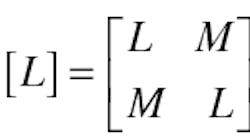Shielded symmetrical bandline transmission lines offer some noteworthy characteristics for high-frequency designs, including low signal loss. In order to better understand the nature of these transmission lines, they were examined using the finite-element method (FEM) 1,2 method-of-moments (MoM) analysis, 3 and curve-fitting techniques. Through these analysis approaches, a set of closed-form equations was developed to determine the characteristic impedances and the primary inductance and capacitance matrices (the and matrices, respectively) for a shielded symmetrical bandline. These general expressions provide good accuracy for shielded symmetrical bandlines with a wide range of discontinuity angles, and can be used with band-lines having outer-to-inner conductor-radius ratios of 2 to 7. The design equations were applied to create an RF coupler with high coupling ratio, and can be readily implemented in modern computer-aided-engineering (CAE) software tools for the design of couplers, resonators, 4 filters, and probes among other microwave and wireless components.
and
LO = the proper inductance of the isolated line,
CO = the proper capacitance of the isolated line,
M = the mutual inductance of the coupled line, and
γ= the coupling capacitance of the coupled line.
A variety of numerical techniques are available to accurately determine the characteristic impedance and the primary parameters of the coupled line. But they are time-consuming and too tedious for use in circuit design, where closed-form analytical models are to be preferred. By applying FEM and MoM analyses along with curve-fitting strategies, it is possible to develop these closed-form expressions for determining the characteristic impedance and primary parameters of coupled shielded symmetrical bandline. Figure 1 offers a cross-sectional view of a shielded symmetrical bandline. The line is assumed to be lossless. It has inner conductor radius of ro, with negligible thickness w, outer shield radius of rb, and discontinuity angle of θ.
Numerical results for the characteristic impedances of a shielded symmetrical bandline as determined by the FEM and MoM approaches are shown in Fig. 2 and Fig. 3. The close match of the results demonstrates good coherence between the two methods. The FEM analysis approach was also used to determine the effects of the discontinuity angle on different parameters for the shielded symmetrical bandline, with the results shown in Fig. 4, Fig. 5, Fig. 6, and Fig. 7.
Page Title
The derivation of the closed-form expressions for a shielded symmetrical bandline is as follows. The even-mode impedance (Zoe) of a shielded symmetrical bandline can be expressed by Eq. 1 for 2 < r < 7 and 0 < θ < 180 deg.
where:
For 2 < r < 7 and 0 < θ < 60 deg., the odd-mode impedance can be given by:
where:
For 2 < r < 7 and 60 <θ < 180 deg., the odd-mode impedance can be given by:
where:
The proper and mutual inductances of the coupled line are given by Eqs. 4, 5, and 6.
For 0 <θ < 60 deg.:
where:
Page Title
For 60
where:
The mutual inductance of the coupling line can be found from:
where:
Equations 7, 8, and 9 give the proper-and the coupling capacitances of the coupled line formed with shielded symmetrical bandline.
For 0
where:
For 60
where:
Page Title
The value of the coupling capacitance of the coupled line can be found from:
where:
Figure 8 presents the structure of a directional coupler using the coupled line with symmetrical bandlines. The fixed parameters of the coupler include a characteristic impedance of 50 ohms, desired coupling coefficient between the two lines of 20 dB, and an operating frequency of 1.5 GHz. The features of the coupling line obtained from the proposed relationships include a dielectric constant of 12.75, a radius ratio, rb/ro, of 2.3, a discontinuity angle of 157 deg., a coupler length of 14 mm, even-and odd-mode characteristic impedances, Zoe and Zoo, respectively, of 55.28 and 45.22 ohms.
The inductance matrix appears as:
while the capacitance matrix appears as:
Figure 9 shows that in the frequency-range of 1 to 2 GHz, coupling is about 20 dB.
In conclusion, this article has presented a set of accurate, closed-form formulas for the primary parameters ( and matrices), and the coupled line even-and odd-mode impedances of a shielded symmetrical bandline transmission line.
The expressions obtained from the FEM and MoM approaches are valid in a wide range of values for the discontinuity angle and the outer-to-inner conductor radius ratio. The formulas were used as the basis for designing a directional coupler, which delivered about 20 dB coupling at 1.5 GHz.
REFERENCES
- N. Ben Ahmed, M. Feham, and M. Kameche, "Finite Element Analysis of Planar Couplers," Applied Microwave and Wireless, Vol. 12, No. 10, October 2000.
- N. Ben Ahmed and M. Feham, "Finite Element Analysis of RF Couplers With Sliced Coaxial Cable," Microwave Journal, Vol. 43, No. 11, November 2000, pp. 106-120.
- A.R. Djordjevic, D. Darco, M.C. Goran, T.K. Sarkan, Circuit Analysis Models for Multiconductor Transmission Lines, Artech House, Norwood, MA, 1997.
- N. Ben Ahmed and M. Feham, "Design NMR Probes At High Frequencies," Microwaves & RF, Vol. 41, No. 2, February 2002.























